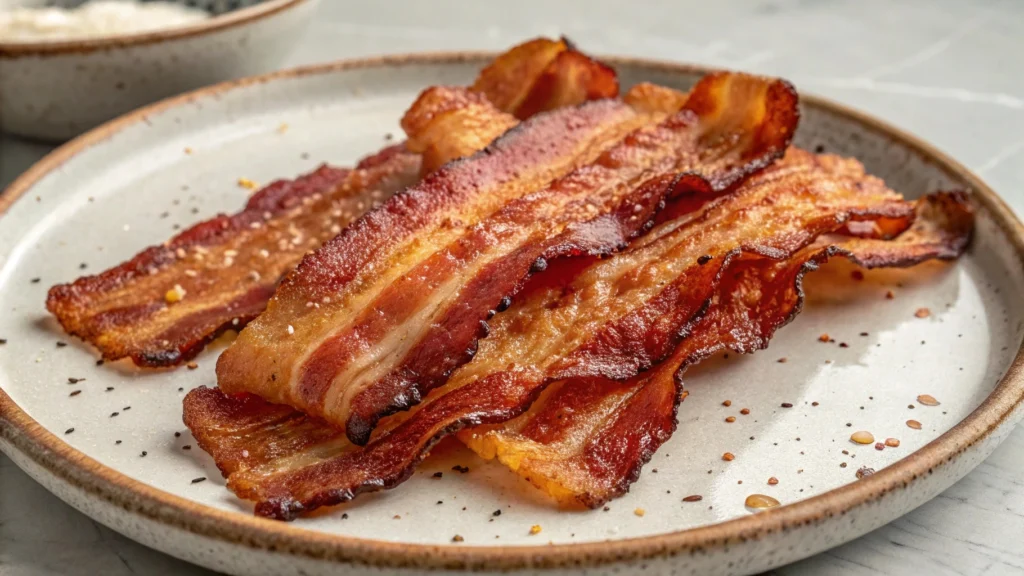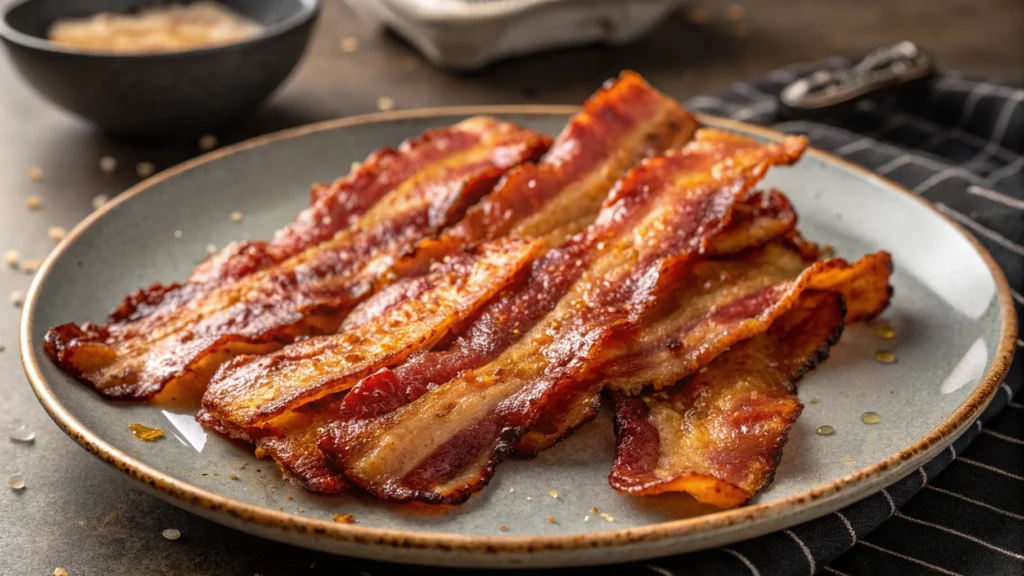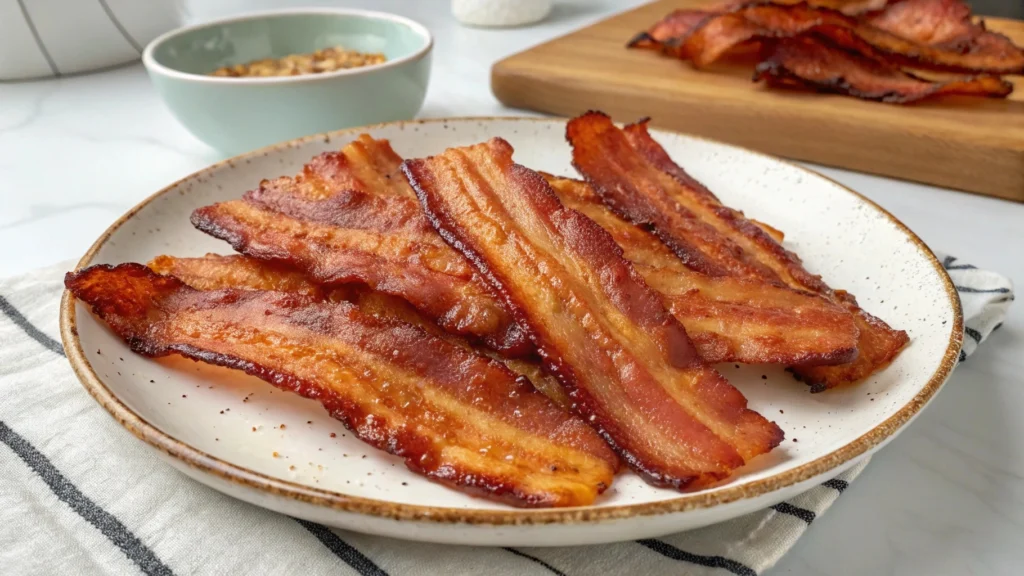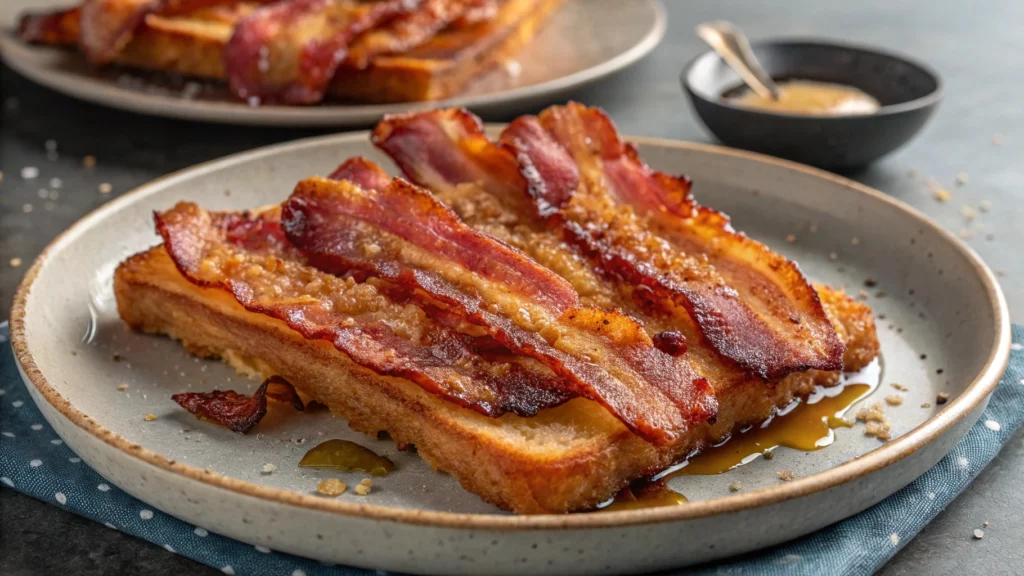The Bacon Struggle is Real – And You’re Not Alone
Picture this Cook bacon: it’s a lazy weekend morning, and all you want is the perfect plate of crispy bacon. But instead, you end up with a greasy mess—half burnt, half raw. We’ve all been there. The good news? You’re about to discover how to cook bacon perfectly every single time, no matter your method or skill level. Whether you’re a weekend warrior or a breakfast pro, this guide will help you unlock that golden crispiness you crave without the smoke, splatter, or stress.

Why Cooking Bacon Right Matters
The Health and Flavor Payoff
- Well-cooked bacon reduces excess grease and boosts flavor.
- Proper crisping enhances taste and texture without overloading fat.
- Bacon cooked right is safer—less risk of undercooked pork.
Common Bacon Cooking Mistakes
- Overcrowding the pan (causes uneven cooking)
- Starting with high heat (leads to burning)
- Not draining properly (results in soggy slices)
Understanding the Types of Bacon
- Thin-cut: Cooks fast, best for crispy fans.
- Thick-cut: Meatier, great for chewy bacon lovers.
- Nitrate-free or smoked bacon: Ideal for health-conscious or gourmet taste.
Crispy vs. Chewy – Know Your Texture
- Decide your preference before you cook.
- Adjust heat and cooking time accordingly.
Best Ways to Cook Bacon
Skillet or Stovetop Method
- Classic method, more control over texture.
- Medium heat works best—cook slowly to prevent curling.
Oven-Baked Bacon
- Pros: Less mess, ideal for large batches.
- Use foil-lined baking sheets for easy cleanup.
- Set oven to 400°F (204°C), cook 15–20 mins.
Air Fryer Bacon
- Healthier: Less grease retention.
- Time-saving: 8–10 minutes at 350°F (175°C).
- Flip halfway for even crispness.
Microwave Bacon
- Good for quick fixes.
- Best for thin-cut bacon only.
- Use a paper towel layer above and below.

Step-by-Step Guide to Cooking Bacon Perfectly
Stovetop (Skillet) Method
Ingredients & Tools Table
| Item | Quantity/Details |
|---|---|
| Bacon | 4–8 slices |
| Cast iron skillet | 1 (preferred) |
| Tongs | 1 |
| Paper towels | For draining |
- Lay bacon in a cold skillet.
- Turn on medium heat; let fat render slowly.
- Flip with tongs every 2–3 minutes.
- Drain on paper towels.
Oven-Baked Bacon
Instructions
- Preheat oven to 400°F.
- Line baking sheet with foil; place wire rack if available.
- Lay bacon flat, no overlapping.
- Bake 15–20 minutes. No flipping needed.
Air Fryer Bacon
Instructions
- Preheat to 350°F.
- Lay bacon in a single layer.
- Cook for 8–10 minutes.
- Flip halfway for even crisping.
Pro Tip: Use Paper Towels for the Final Touch
- Removes excess grease.
- Keeps bacon crisp even after cooling.
Tips for Crispy, Flavorful Bacon Every Time
Choose the Right Bacon
- Look for marbling: good fat-to-meat ratio.
- Consider smoked or maple varieties for flavor.
Control the Temperature
- Start with medium heat, avoid high-heat sear.
- Cook slow and steady for best texture.
Avoid the Splatter
- Use a splatter screen for stovetop.
- Bake on foil with raised rack to avoid fat pooling.
Don’t Toss the Grease
- Store bacon grease in a glass jar.
- Use for sautéing veggies or frying eggs.

Expert Tips for Perfectly Cooked Bacon
Start with a Cold Pan for Even Cooking
Beginning your bacon in a cold pan allows the fat to render slowly, promoting even cooking and reducing the risk of burning. This method ensures that the meat and fat cook uniformly, resulting in a crisp yet tender bite.
Bring Bacon to Room Temperature
Allowing bacon to sit at room temperature for about 15 minutes before cooking helps it cook more evenly. Cold bacon can cause the fat to render too quickly, leading to uneven texture and potential burning.
Avoid Overcrowding the Pan
Placing too many bacon strips in the pan can lead to uneven cooking and soggy results. Ensure there’s enough space between each slice to allow proper heat circulation and crispiness.
Innovative Cooking Methods
Water Method for Crispy Bacon
Adding a small amount of water to the pan when cooking bacon can prevent burning and reduce splatter. As the water evaporates, it allows the bacon to cook evenly and become crispy without the mess.
Baking Bacon in a Cold Oven
Placing bacon in a cold oven and then setting it to 400°F can result in evenly cooked, crispy bacon. This method allows the bacon to cook gradually as the oven heats up, reducing the chances of burning.
Common Mistakes to Avoid
Cooking on High Heat
Using high heat can cause bacon to cook too quickly, leading to burnt edges and undercooked centers. Opt for medium to medium-low heat to allow the fat to render properly and achieve desired crispiness.
Not Draining Excess Grease
After cooking, place bacon on paper towels to absorb excess grease. This step is crucial for maintaining crispiness and reducing greasiness.
Cooking Times & Doneness Chart
Understanding how long to cook bacon for your preferred texture can make all the difference. Use this quick-reference chart to guide your cook times by method and doneness.
Bacon Doneness Table
| Cooking Method | Doneness | Time Estimate | Temperature | Notes |
|---|---|---|---|---|
| Stovetop (Skillet) | Chewy | 5–6 minutes | Medium heat | Flip often for even cooking |
| Stovetop (Skillet) | Crispy | 8–10 minutes | Medium heat | Lay flat; don’t overcrowd |
| Oven | Chewy | 12–14 minutes | 375°F (190°C) | Start checking at 12 mins |
| Oven | Crispy | 15–18 minutes | 400°F (204°C) | Use rack to let fat drip off |
| Air Fryer | Chewy | 6–7 minutes | 350°F (175°C) | Use single layer only |
| Air Fryer | Crispy | 8–10 minutes | 370°F (188°C) | Check halfway to avoid burning |
| Microwave | Crisp only | 4–5 minutes (4 slices) | High power | Use paper towels to absorb grease |
Tip: Cooking times vary based on bacon thickness and your appliance. Always keep an eye on the first batch.
Delicious Ways to Use Leftover Bacon
Cooking bacon perfectly isn’t just about the method—it’s about what you do with it. Use your crisped slices in these mouthwatering ways.
Recipes Featuring Cooked Bacon
- Bacon-Wrapped Asparagus: Roast asparagus stalks wrapped in cooked bacon for a quick side.
- Loaded Bacon Potato Skins: Add crispy bacon to baked potato halves with cheddar and green onions.
- Bacon and Egg Breakfast Tacos: Combine scrambled eggs, cheese, salsa, and bacon in a tortilla.
Meal Ideas
- BLT Sandwiches: A classic that never fails. Use toasted sourdough, fresh lettuce, and tomatoes.
- Bacon Mac and Cheese: Fold chopped bacon into creamy mac and cheese for a smoky flavor boost.
- Salad Toppings: Crumble bacon over Caesar or spinach salads for texture and saltiness.
Healthier Alternatives and Nutritional Info
Yes, bacon can be part of a balanced diet—if you know what to look for.
Types of Bacon with Better Nutritional Value
- Turkey Bacon: Lower in fat and calories but also less crispy.
- Uncured Bacon: No added nitrates; often labeled “natural” or “organic.”
- Center-Cut Bacon: Comes from the leaner part of the pork belly, with less fat.
Nutritional Comparison (per 2 slices)
| Type | Calories | Fat (g) | Protein (g) | Sodium (mg) |
|---|---|---|---|---|
| Regular Pork | 87 | 7 | 5 | 360 |
| Center-Cut | 70 | 5 | 5 | 320 |
| Turkey Bacon | 60 | 4.2 | 4.8 | 340 |

Final Thoughts
You don’t need to be a chef to cook bacon like a pro. With the right techniques, temperatures, and a little patience, you can achieve golden-brown slices that suit your taste—whether chewy, crispy, or somewhere in between. Cooking bacon perfectly every time is about practice, knowing your equipment, and understanding the bacon itself.
Frequently Asked Questions About Cooking Bacon
How long should you cook bacon for different textures?
- Crispy: 12–15 minutes (oven) or 8–10 minutes (air fryer).
- Chewy: 8–10 minutes (oven) or 6–8 minutes (stovetop).
Can you cook bacon straight from the freezer?
- Yes, but separate slices as they thaw.
- Add extra 3–5 minutes of cooking time.
What’s the healthiest way to cook bacon?
- Oven-baked on a rack (fat drips away).
- Air fryer is a close second.
Is air fryer bacon really better than pan-fried?
- Yes—less grease, evenly cooked, less cleanup.
Can I Cook Bacon in the Microwave?
Yes, cooking bacon in the microwave is a quick and convenient method. Place bacon between layers of paper towels on a microwave-safe plate and cook on high for 4-5 minutes, checking for desired crispiness.
Is Air Fryer Bacon Healthier?
Cooking bacon in an air fryer allows excess fat to drip away from the meat, potentially resulting in a slightly healthier option compared to traditional frying methods. It also produces crispy bacon with less mess.
Final Thoughts – Your Perfect Bacon Awaits
You’ve learned how to cook bacon to perfection—crispy or chewy, stovetop or oven, quick microwave or efficient air fryer. Now it’s time to bring that knowledge into your kitchen. Remember: the key is control, patience, and knowing your tools. Whether you’re preparing a brunch for friends or just making your favorite breakfast sandwich, cooking bacon right transforms the entire meal.
Call to Action
If you found this bacon guide helpful, share it with a fellow bacon lover. Got a favorite trick or variation? Leave a comment below! Don’t forget to subscribe for more kitchen-tested tips that actually work.
Conclusion
By incorporating these expert tips and avoiding common pitfalls, you can master the art of cooking bacon to perfection. Whether you prefer it crispy or chewy, using the right techniques and methods will ensure your bacon is consistently delicious.
